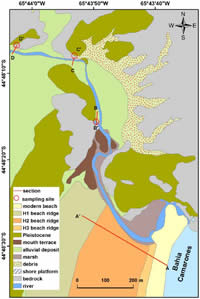Mid-Holocene relative sea-level changes along Atlantic Patagonia: New data from Camarones, Chubut, Argentina
Bini M., I. Isola, G. Zanchetta, M. Pappalardo, A. Ribolini, L. Ragaini, C. Baroni1, G. Boretto, E. Fuck, C. Morigi, M.C. Salvatore, D. Bassi, F. Marzaioli, F. Terrasi (2017)
The Holocene, doi:https://doi.org/10.1177/0959683617714596.
Abstract
This paper concerns the relative sea-level changes associated with the Atlantic Patagonian coast derived from sea-level index points whose elevation was determined by a differential global position system (DGPS). Bioencrustations from outcrops located near Camarones, Chubut, Argentina, consist of autochthonous deposits characterized by Austromegabalanus psittacus (Molina, 1782), encrusting acervulinid foraminifera, coralline red algae and bryozoans. The association of the different organisms is interpreted as being associated with an intertidal environment, and they have been used as index points to establish the relative sea-level position. The main conclusion is that the relative sea-level between c. 7000 and 5300 cal. yr BP was in the range of c. 2–4 m a.s.l., with a mean value of c. 3.5 m a.s.l. Our data seem to support the existence of different rates of relative sea-level fall in different sectors of Atlantic Patagonia during the Holocene and highlight the importance of a more precise and accurate relative sea-level estimation by producing new data and revisiting the indicative meaning of most of the indicators so far used in the area.
http://journals.sagepub.com/doi/pdf/10.1177/0959683617714596


